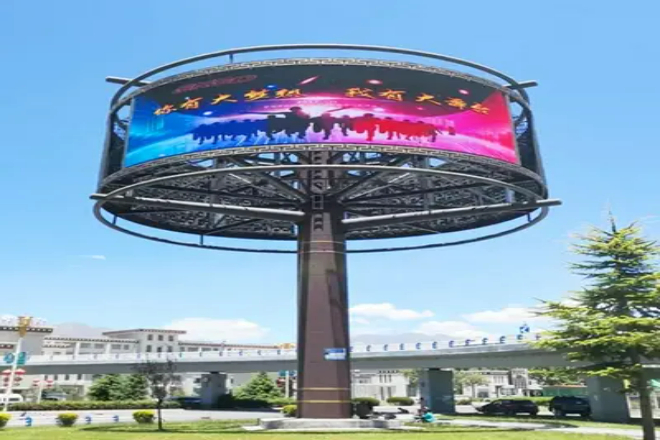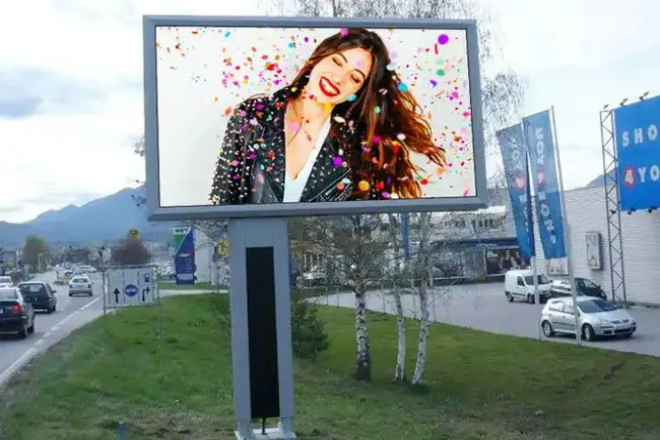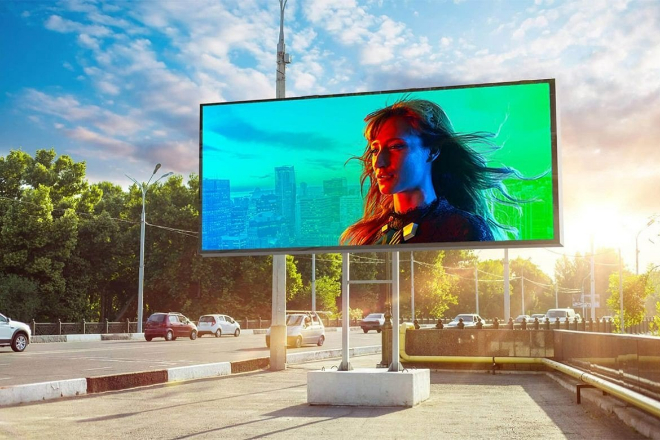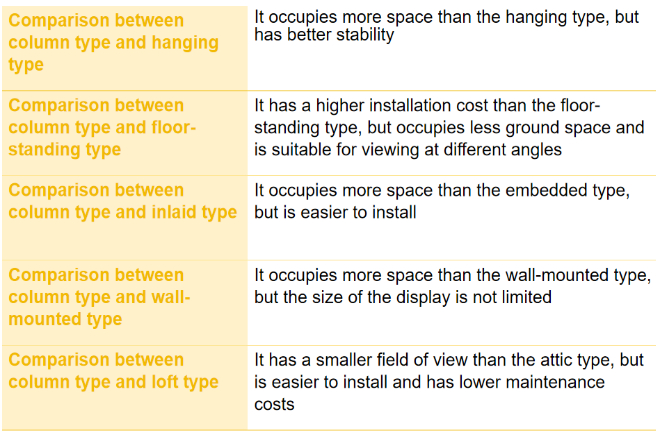Introduction

Most of the common outdoor LED screens we see are installed in a column-type installation. In fact, there are many ways to install outdoor LED screens.
The column-type installation is popular because of its wide field of view and flexible installation location. However, is the column-type installation suitable for all installation environments?
1. Basic introduction to column-type installation
Column-type installation refers to installing the outdoor LED screen on a specially designed column. This installation method is mainly divided into two forms: single column and double column.
A single column has only one support column, while a double column has two side-by-side support columns, which are used for more stable or wider display installation.
Features:
- Wide field of view:
Since the column is usually high, the LED screen installed on the column can cover a wider viewing angle, allowing the audience to clearly see the display content at a longer distance.
- Strong applicability:
It is particularly suitable for relatively open and unobstructed places, such as squares, parking lots, large event venues, etc., and can give full play to its advantage of the wide field of view.
- Structural stability:
Column-type design usually takes into account the influence of natural factors such as wind load and earthquake, so it has high structural stability.
2. Analysis of whether you are suitable for column-type installation

1). Geological conditions
Column-type installation requires a stable geological foundation to support the weight of the display and the column to ensure the safety and stability of the entire structure.
- Soft soil foundation:
Soft soil foundation has low bearing capacity and is prone to settlement and deformation, which is not suitable for direct column-type installation.
If it must be installed on a soft soil foundation, foundation reinforcement treatment is required, such as replacement filling, grouting, or pile foundation reinforcement, to improve the bearing capacity and stability of the foundation.
- Rock foundation:
Rock foundation has a high bearing capacity and good stability, which is suitable for column-type installation. However, it should be noted that the rock foundation may be uneven, and detailed geological surveys and designs are required to ensure that the column can be stably installed on the rock.
- Other geological conditions:
For other types of geological conditions, such as sandy foundations, clay foundations, etc., it is also necessary to evaluate and design according to the specific bearing capacity and stability to ensure the safety and stability of the column-type installation.
2). Wind environment factors
Outdoor LED display screens are susceptible to wind, and column-type installations need to fully consider the local wind environment.
- Possible safety hazards caused by excessive wind:
Excessive wind may cause the display screen and column installed in the column to tilt or collapse, causing property damage and casualties.
3). Space and sight distance requirements
Column-type installation requires sufficient space to set up the column and display screen while considering the requirements of sight distance and viewing angle.
The impact of installation height and angle on sight distance and viewing angle:
- Installation height:
The higher the installation height, the farther the sight distance, but the viewing angle may become smaller. Therefore, when choosing the installation height, it is necessary to comprehensively consider the requirements of sight distance and viewing angle.
- Installation angle:
The installation angle should be reasonably adjusted according to the position and line of sight of the audience to ensure that the audience can see clear and complete display content.
- Analysis and suggestions:
Before installation, the installation site should be measured and planned in detail to determine the appropriate installation position and angle. At the same time, consider the position and line of sight of the audience to ensure that the display content can be clearly seen by the audience.
3. What are the limitations of column-type installation?

1). Topographical restrictions
Although column-type installation has advantages such as a wide field of view and stable structure, its application is subject to certain restrictions under complex topographical conditions.
- Mountain restrictions:
In mountainous areas, the terrain is undulating and steep, and the difficulty and risk of column-type installation are greatly increased.
The geological conditions in the mountains are complex, and there may be risks of natural disasters such as landslides and collapses, which pose a serious threat to the stability of the columns.
- Slope restrictions:
Slope terrain also poses challenges to column installation. The inclination of the slope may cause the column to be unstable and prone to tilting or collapse.
In addition, there may be soil erosion problems on the slope, which affects the foundation stability of the column.
Therefore, under complex topographical conditions such as mountains and slopes, it is necessary to carefully consider the feasibility of column installation and, if necessary, take additional reinforcement measures or choose other installation methods.
2). Building structure restrictions
When installing a column-type LED display on an existing building, it may be restricted by the building structure.
- Load-bearing capacity limitation:
The roof or wall of the building may not be able to bear the weight of the column and display screen, and structural reinforcement or lightweight design is required.
- Space limitation:
There may not be enough space around the building to set up the column and display screen, especially when the building is located in a busy urban area or narrow streets.
- Aesthetic considerations:
Column installation may affect the overall aesthetics of the building and needs to be coordinated with the style of the building.
Therefore, when installing a column-type LED display screen on an existing building, it is necessary to consider the load-bearing capacity, space limitations, and aesthetic requirements of the building structure fully to ensure the safety and coordination of the installation.
3). Cost considerations
Column installation requires the production of screen steel structure and concrete or steel columns, which is relatively expensive and is another major limitation.
- Material cost:
The production cost of steel structure materials and concrete or steel columns is high, especially when high-strength and corrosion-resistant materials are required.
- Construction cost:
Column installation requires professional construction teams and equipment, a long construction period, and high manpower and material costs.
- Maintenance cost:
Column-mounted display screens and columns require regular maintenance and overhaul, and the maintenance cost is also relatively high.
In contrast, other installation methods, such as wall-mounted and suspended installation, may have lower costs. Wall-mounted installation can use the wall of the building as support, saving materials and construction costs; suspended installation can use the building structure or a specially set bracket for suspension, which can also reduce costs.
In summary, column installation has certain limitations in terms of topography, building structure, and cost. When choosing an installation method, it is necessary to comprehensively consider various factors and choose the most suitable installation method to ensure the safety, stability, and economy of the installation.
4. Selection and comparison of other installation methods

1). Suspension installation
- Features:
Suspension installation (cantilever installation) extends and fixes the display screen through the cantilever structure, and the display screen can be suspended in the air.
This method can flexibly adjust the angle and position of the display screen, allowing the audience to watch better from different angles.
The cantilever structure needs to have sufficient strength to support the weight of the display screen, and factors such as wind resistance must be considered.
- Applicable scenarios:
Suitable for outdoor stages, stadiums, and other places. For example, at the edge of the competition venue of an outdoor stadium, the cantilever-mounted display screen can facilitate spectators and athletes to watch game information, scores, highlights, and replays from all angles.
1.1). Compared with column installation:
- Flexibility:
Suspension installation is more flexible, and the angle and position of the display can be adjusted as needed, while column installation is relatively fixed.
- Space occupancy:
Suspension installation does not occupy ground space, while column installation requires a certain amount of ground space.
- Stability:
Column installation has higher stability due to the stable column support, while suspension installation requires a stronger cantilever structure and wind-resistant design.
2). Floor Installation
- Features:
Floor installation is to place the display directly on the ground and fix it with a bracket or base. This method is simple to install and has high stability, but it occupies a large ground space.
- Applicable scenarios:
Suitable for places with flat ground and sufficient space, such as large squares, parking lots, etc. It is also often used to support heavy equipment or when the equipment itself is heavy, such as large machinery, shelves, etc.
2.1). Compared with column installation:
- Space occupancy:
Floor installation occupies a large ground space, while column installation saves relatively ground space.
- Flexibility:
Column installation can flexibly adjust the height and position of the display screen to meet different viewing needs while floor-standing installation is relatively fixed.
- Cost:
Floor-standing installation has a relatively low cost because it does not require the production of complex column structures, while column installation has a higher cost.
3). Embedded installation
- Features:
Embedded installation is to embed the display screen into the reserved space of the building wall, ground, or other structures so that the display screen is seamlessly connected to the surrounding environment and looks more natural and beautiful.
At the same time, this installation method also has a certain enhancement effect on the protection of the display screen.
- Applicable scenarios:
It is often used in places with special architectural designs, such as modern art centers, high-end commercial complexes, etc.
For example, the display screen is embedded in the exterior wall of the art center as part of the architectural decoration to display artworks or event information.
3.1). Compared with column installation:
- Aesthetics:
Embedded installation is more beautiful and integrated with the surrounding environment, while column installation is relatively abrupt.
- Space occupation:
Embedded installation does not take up additional space, while column installation requires a certain amount of ground space.
- Installation difficulty:
Embedded installation requires pre-reserved space and close coordination with the building structure, which makes installation more difficult, while column installation is relatively simple.
4). Wall-mounted installation
- Features:
Wall-mounted installation is to fix the display screen directly on the wall or bracket of the building, which is simple to install and saves space. This method is suitable for relatively flat walls indoors or outdoors.
- Applicable scenarios:
Suitable for commercial building exterior walls, hotels, office buildings, and other places for playing advertisements, displaying brand images, or issuing notices. It is also commonly used for the installation of indoor LED display screens and door head screens.
4.1). Compared with column installation:
- Space occupation:
Wall-mounted installation saves space and does not occupy ground space, while column installation requires a certain amount of ground space.
- Flexibility:
Column installation can flexibly adjust the height and position of the display screen to meet different viewing needs, while wall-mounted installation is relatively fixed and is limited by the position and size of the wall.
- Installation difficulty:
Wall-mounted installation is relatively simple, while column installation needs to consider issues such as foundation treatment and column stability.
5). Rooftop installation
- Features:
Rooftop installation is to install the display screen on the roof of the building, which is high in position, has a long visible distance, and has wide coverage. When installed on the roof, it is generally not blocked by ground objects and has a wide field of view.
- Applicable scenarios:
Suitable for urban landmark buildings, large shopping malls, stations, and other places. If the display screen is installed on the roof of the station building, train timetables, advertisements, and other information can be released to people in the surrounding areas of the station.
5.1). Compared with column installation:
- Field of view:
Both rooftop installation and column installation have the characteristics of a wide field of view, but the rooftop installation position is higher, and the visible distance is farther.
- Installation difficulty:
Rooftop installation needs to consider the load-bearing capacity, waterproofing, and lightning protection of the building. The installation difficulty is relatively large, while column installation is relatively simple.
- Maintenance cost:
Rooftop installation may have a high maintenance cost due to its high position, while column installation is relatively easy to maintain and repair.
In summary, different installation methods have their own advantages and disadvantages. Which method to choose needs to be comprehensively considered based on factors such as the actual installation environment, usage requirements, budget, and maintenance cost.
Conclusion
In summary, column installation, as a common installation method for outdoor LED display screens, has its unique advantages and applicability. However, when choosing an installation method, we must fully consider geological conditions, wind environment, space and sight distance requirements, maintenance and repair convenience, and cost.
Through comprehensive analysis and comparison, we can find that column installation is not suitable for all installation environments but needs to be selected and adjusted according to specific circumstances.
Finally, if you want to know more about LED display screens, please get in touch with us.
